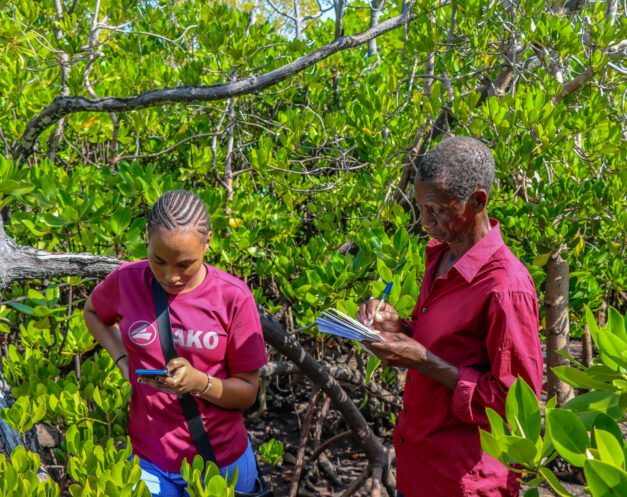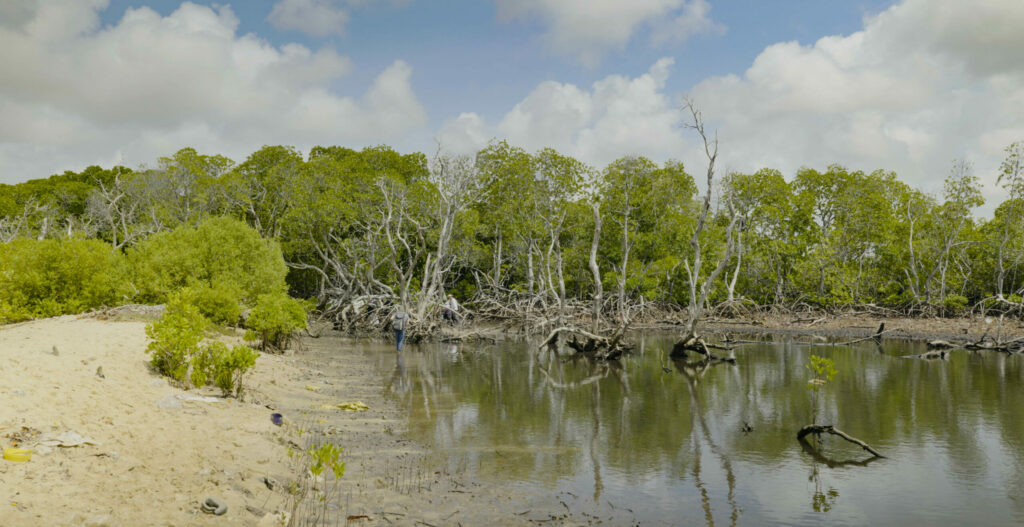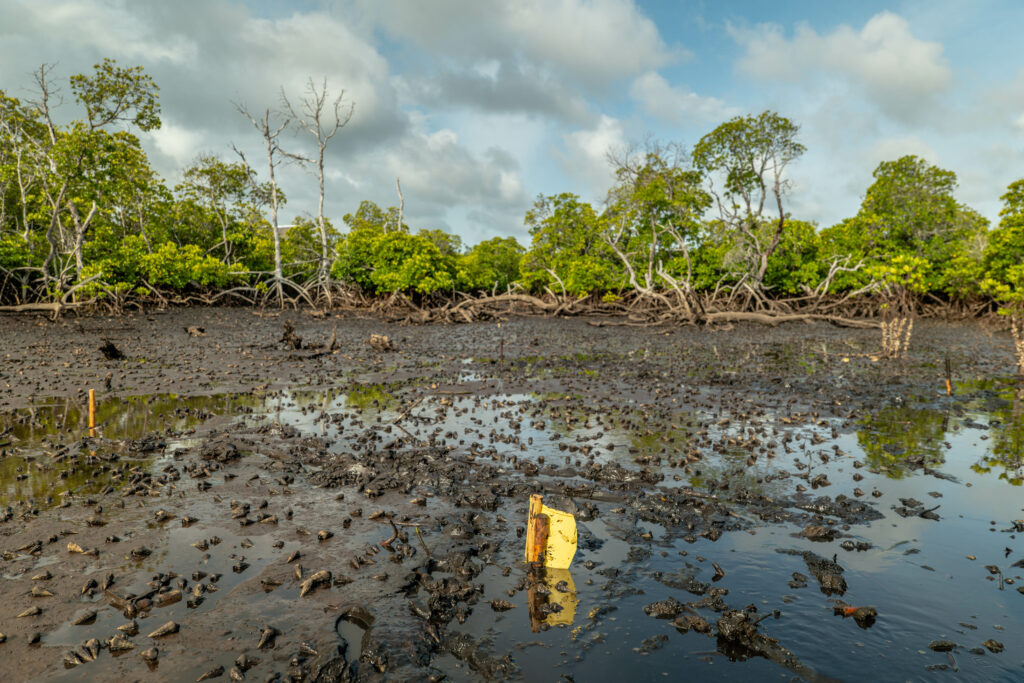Community-based ecological mangrove restoration in Kenya

Kenya holds significant potential for mangrove restoration, with over 1,600 hectares of completely lost mangroves identified for recovery, and an additional 23,000 hectares of degraded mangroves that can be restored to good ecological condition. Wetlands International focuses its efforts on the Tana Delta and Lamu, areas that together host 66% of the country’s total mangroves and are rich in biodiversity. With Mangrove Action Project and Kenya Forest Service (KFS), we are working with the local communities and other stakeholders in the restoration of mangroves using the Community-Based Ecological Mangrove Restoration approach.
The lives of Kenya’s coastal communities are closely intertwined with its mangroves. They rely on them for food, poles for house construction, wood fuel, traditional medicine and therapy. In Lamu, mangroves contribute nearly USD 85 million per year to the national economy and sustain the livelihoods of about 800,000 artisanal coastal fishermen. They also store up 3% of Kenya’s total fossil fuel emissions each year. Kenya’s mangroves, however, face threats from numerous human activities like overharvesting, mining, climate change and agricultural development.
Mangrove restoration activities in Kenya have as recently as 2020 focused mainly on planting. But studies indicate that about 80% of global mangrove planting initiatives are prone to failure. In Lamu, for example, most restoration initiatives have focused on planting and ignored the crucial aspects of the restoration process – mainly biological, social, historical and political.
Nature can heal itself when given the chance
To address this challenge in Lamu, Wetlands International has been partnering with Mangrove Action Project since 2019 to train local communities, forest managers, national and sub-national government officials and other stakeholders on the Community-Based Ecological Mangrove Restoration (CBEMR) approach. CBEMR, unlike many planting projects, takes into account mangrove biology and ecology in addition to the socio-economical aspects that can affect restoration efforts. By so doing, it mimics natural processes such as regeneration to produce a more biodiverse mangrove forest in a cost-effective and efficient way.
Where natural regeneration of mangroves is not possible, the CBEMR approach looks into the factors hindering natural regeneration such as poor hydrology, site history, pollution, socio-economic conditions, among others and active planting is only done when necessary to support natural regeneration.
Thus far, Wetlands International restored 116 hectares of mangroves directly and indirectly using the Community-Based Ecological Mangrove Restoration (CBEMR) approach in Kenya. In addition, we have enhanced the conservation status of over 38,000 hectares of mangroves in Lamu and Tana Delta through participatory management planning, patrolling, training, awareness raising, and supporting alternative livelihoods.
Learning and demonstration project
Following successful CBEMR training in Lamu, Wetlands International established a learning and demonstration site in partnership with the KFS in the Kitangani area, where planting failed many times. We addressed underlying hydrological challenges to natural mangrove regeneration and restored environmental conditions such as soil, oxygen and nutrient quality. Monitoring after six months showed clear improvement, with free-flowing water and visible signs of regrowth showing how successful correctly applied EMR approaches can be. This impactful restoration effort holds great promise for the revival of the wider Kitangani mangrove ecosystem.


In areas affected by the 1997-98 El Niño event, we implemented assisted mangrove planting, as natural regeneration has not been possible despite the area previously supporting healthy mangrove forests. The prolonged flooding during El Niño suffocated existing mangroves, and the site has struggled to recover ever since. Although there is a natural supply of seedlings, the vastness of the area and strong tidal currents prevent them from taking root—leaving the land persistently bare. A compelling example of the success of assisted planting can be seen in Pate, where areas degraded for decades are now showing strong signs of recovery.
Enhancing national mangrove policies and plans
To scale up science-based mangrove restoration, Wetlands International Kenya and its partners (WWF, TNC and IUCN) support policymakers to institutionalize best practice mangrove restoration within government strategies. We have:
- Provided our advise for the National Mangrove Ecosystem Restoration Guideline, which incorporates the CBEMR approach, which has been finalised and validated. The Guidelines build amongst others on the Best Practice Guidelines on Mangrove Restoration (GMA, 2023)
- Supported the inclusion of mangrove conservation and restoration targets in Kenya’s National Biodiversity Strategy and Action Plan (NBSAP)
- Supported the establishment and operationalization of the National Mangrove Management Committee (NMMC) and County Mangrove Management Committee (CMMC)
Global Mangrove Watch
Lamu county, unlike any other in Kenya, grants local communities the right to harvest mangroves for income through structured licensing from the KFS. Despite the existence of these regulations, illegal harvesting still occurs. Without proper monitoring, these illegal activities can go unchecked.
To combat this, the KFS established a national forest alert system, that sends bi-weekly updates on mangrove disturbances in protected areas. However, verifying these alerts (i.e. differentiating legal from illegal harvesting) is tricky without on-the-ground confirmation.
This is where the Global Mangrove Watch (GMW) platform steps in, offering a game-change solution. With its high-resolution planetary imagery, GMW offers a detailed view of mangrove changes, allowing forest managers to scrutinize alerts before sending patrols to investigate potential instances of illegal harvesting.
On request of FAO and the Kenya Forest Service, we are also providing our Global Mangrove Watch data to help Kenya report on its global environmental commitments, such as its Nationally Determined Contributions (NDCs) under the Paris Agreement.
The future of Kenya’s mangroves
To achieve lasting impact, Wetlands International aims to address key barriers to large-scale restoration, such as complex land tenure issues in restorable areas, the wider adoption of CBEMR, and the enforcement of laws that protect mangroves against other threats such as illegal cutting.
To achieve this, we need mangrove programmes scaled up to the landscape level, long-term financing and large-scale investment in mangrove restoration, capacity building on best practice mangrove restoration and the approval of various important policies.
With the right investments and policy support, Kenya has the potential to lead the region in restoring mangrove ecosystems as natural storm barriers, thriving hubs of biodiversity, carbon sequestration, and sustainable livelihoods.
Wetlands International is a founding partner of the Global Mangrove Alliance and together with our partners we have established the Kenya GMA national chapter, which will be instrumental to tackle critical barriers to mangrove restoration in Kenya. It also a promising vehicle to secure funding from international donors and climate finance mechanisms and to align with the Mangrove Breakthrough, a global commitment to safeguarding 15 million hectares of mangroves worldwide by 2030.


